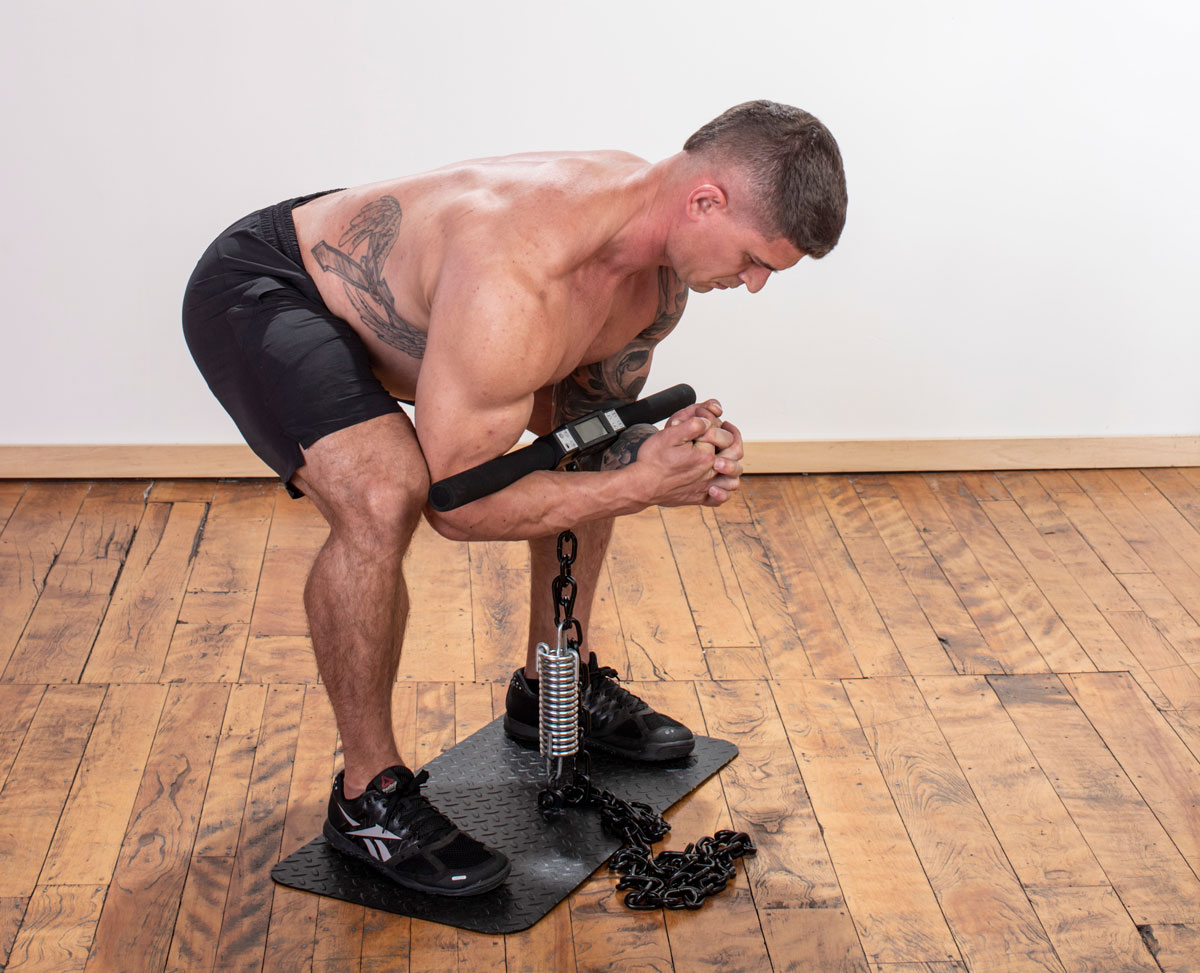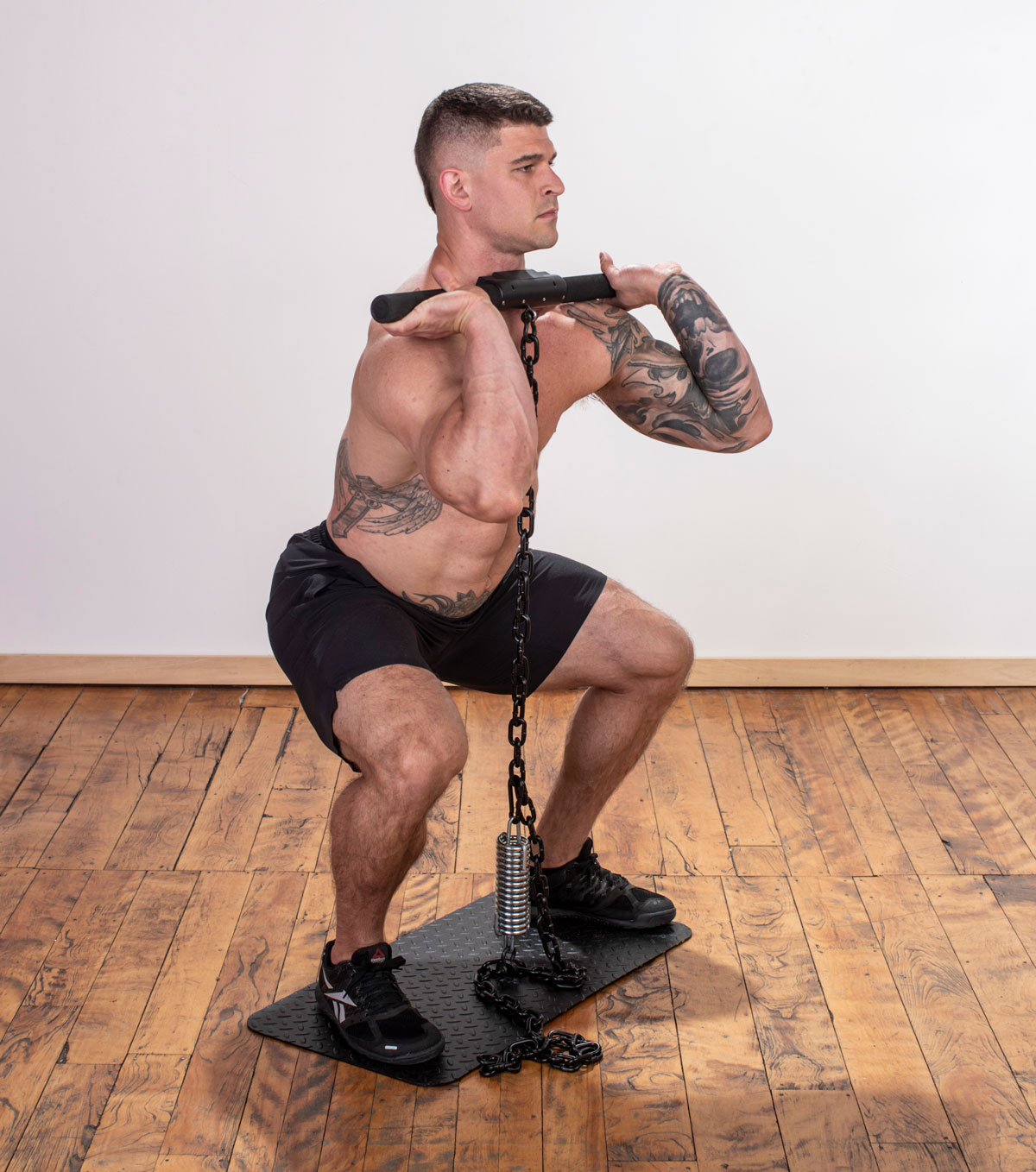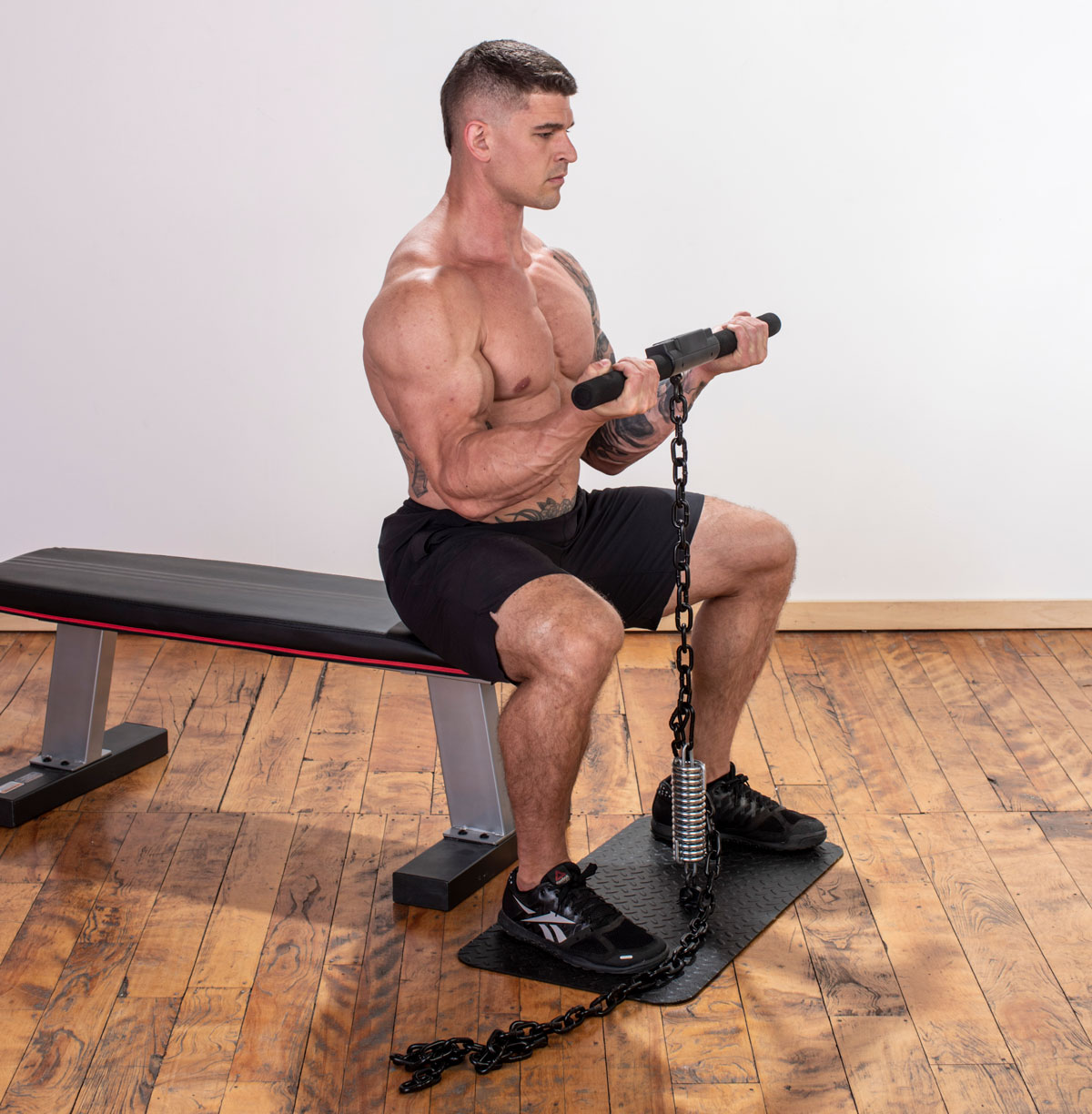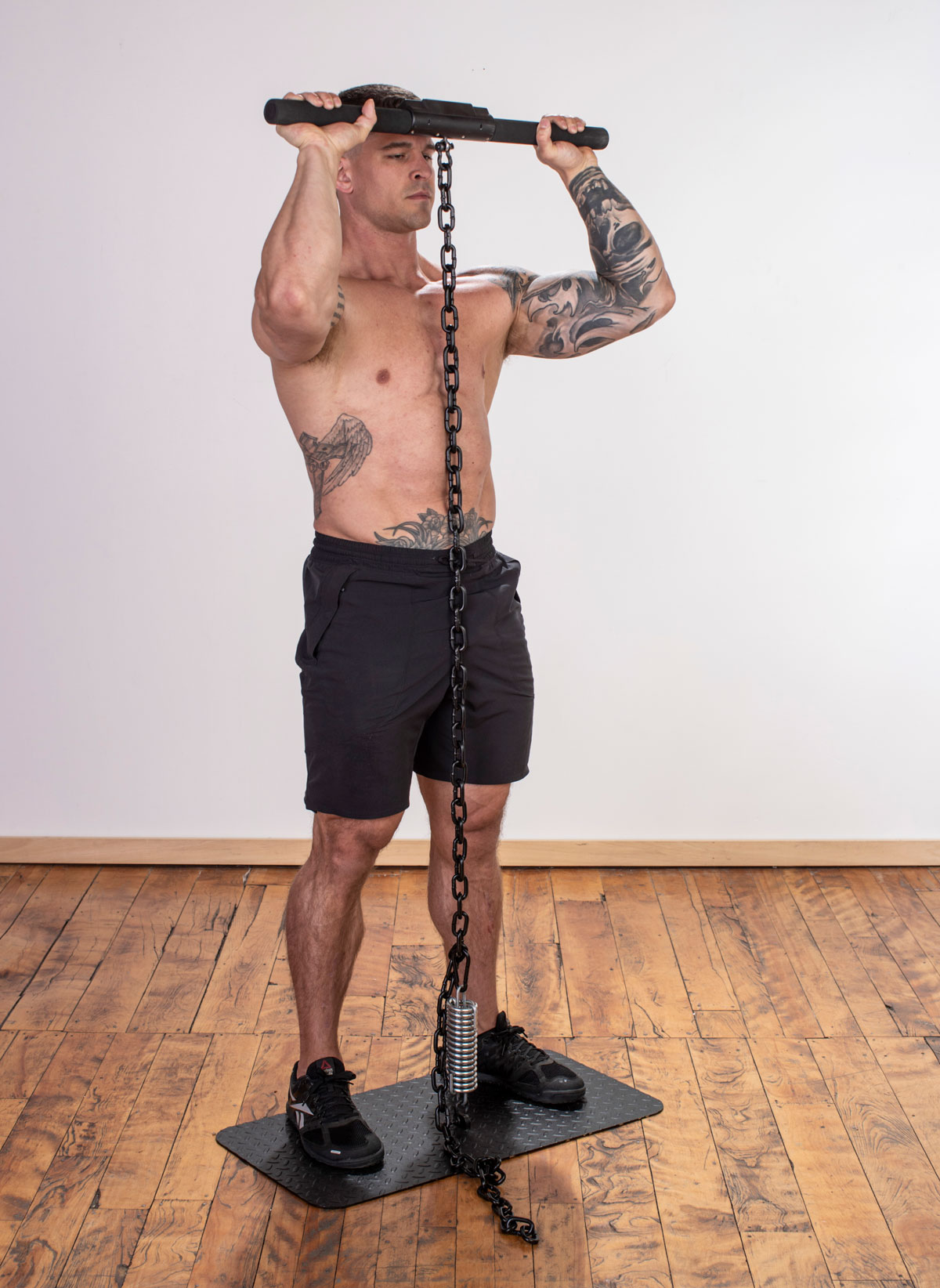Why the Isochain? Unlocking Superhuman Strength—Fast
by Paul “Coach” Wade
There is a "secret" of incredible power which was already known to all the old-time strongmen. It’s a notion we rarely even think about as we train day-to-day, but it’s a concept fully understood by modern physiology, myology and neurology.
The secret is this:
You are already incredibly strong.
We all know the urban legends about normally weak and mild-mannered women lifting cars off trapped loved ones—turns out though, these "myths" are true.1 We can typically only access a relatively small percentage of our motor units, voluntarily. When they are all accessed—perhaps due to a strong electric shock—our muscles clench with such frightening force that they can actually shatter the bones they are attached to.2 None of this power comes from the electricity; it comes straight from the muscles.
You might be saying: Yo, Paulie…if I’m already that damn strong, how come I can’t bend steel bars and punch through brick walls?
The answer is—cortical inhibition. Your brain puts some serious blocks on your ultimate strength. Your muscular power is like a huge reservoir, and cortical inhibition is like a dam, holding all that power back.
This is no bad thing, for the most part. Our muscles are capable of generating so much power, it makes sense for the brain to act as dampener, to preserve energy and keep us safe from ourselves. We often only get to experience the lion’s share of our muscles true power when we are in a life-threatening situation of emergency. Scientists call this phenomenon hysterical strength.
The real key to going from "average person" to "Spiderman" is learning to consciously turn off this cortical inhibition.

Most people understand that this can be done; typically, through many years of gradual, progressive training, where the athlete slowly "re-educates" his or her nervous system to allow the muscles to express more and more of their inherent force, unlocking small bundles of fiber, bit-by-bit, cell-by-cell.
What many people do not know is that this process can actually be accomplished more rapidly. Really rapidly. It shouldn’t take decades of heavy, grinding workouts to triple your baseline strength and get solid as f***. If you use special techniques, you can achieve elite strength in a matter of months.
So—what are these "special techniques"?
Superhuman strength—the three factors
There are three tactical approaches you can combine to sprint beyond former limitations and learn to unlock your max strength at an accelerated rate. These three are:
- Isometric training;
- Strength biofeedback; and
- Tension techniques.
Each of these approaches works incredibly well on its own in amplifying strength levels. If you can combine these three into a synergy, you have the
ultimate strength methodology. Hands down. You also have an approach which increases speed,
3 improves cardiovascular health and fitness,
4 and actually prevents new joint injuries, while healing old aches and pains.
5 There are many, many
other benefits, also.
Isometrics
When German physiologists first brought isometric strength training to the attention of the scientific world, the subjects of their experiments increased their absolute strength, on average, by 5% per week.
6 (You read that right—double your strength in five short months!)
That’s not all. When he reviewed the subsequent studies two decades later, the lead researcher discovered that some individuals—outliers—had increased their strength
by as much as 12% in a single week.
7 The scientific world has been in consensus ever since—isometrics get you strong. Fast.
Why is isometric strength training—
correctly applied—so damn effective? There are various factors at play here, but I’ll outline some of the fundamentals.
If you want to de-train your cortical inhibition to allow you to recruit more motor units at will, you need to expose it to the heaviest possible loads, regularly. These loads "grease" the neurological pathways that activate muscle fibers, making them easier to access voluntarily later (according to a law of neurology called
Hebb’s Rule).
Light weights won’t work. Pink dumbbells won’t cut it. To make more and more of those motor units flash "on", you need
serious loads. The heavier the loads you use, the more rapidly this training effect occurs.
Isometrics allows humans to use the heaviest loads possible.
This is obvious, if you think about it—you can hold more than you can lift, right? In physiology, this is called the
force-velocity relationship. The more force your muscles express, the slower they move—until, at maximum levels, they stop moving altogether. This is the essence of true isometric strength training.
These maximum loads—more than the muscles could ever hope to
move—bully the brain into releasing more motor units for use. The potential of every dormant nerve and cell is unlocked. Cortical inhibition is switched off, and the prisoners are set free. It was discovered early on that isometrics recruits many more motor units than traditional training. No other form of training comes close. It’s simple math. God bless the force-velocity relationship, boys and girls.
There is a caveat, however. True isometric training—for maximum strength development—should be done with
maximum possible contractions. All-out effort. It doesn’t have to be for a long time—a handful of six second holds are enough.

Very quickly, this type of training unlocks an individual’s voluntary strength. At first, isometric "virgins" find they can’t actually use that much force. After a few sessions, my athletes are pushing and pulling so hard, it almost scares them. All this "new" strength appears from nowhere. It’s like a floodgate opens as their cortical dampening shuts down.
Then, I teach them to push even harder.
If you train intelligently and shake up your program every few weeks to avoid becoming stale, you can keep pushing your limits further and further than you ever thought possible. How far? As the world champion weightlifter and isometric pioneer Bill March said: "If you are wondering about hitting a limit poundage with this routine – don’t. I do not believe there is one!"8
Some folks will say: but you’re not moving! How can this train your muscles? Individual muscle cells are binary entities. They fire according the All-or-None Law—they either contract completely, or they don’t contract at all. The only factor at play during resistance training is how many of those cells are recruited. Your muscles don’t know anything about movement. That’s your brain’s job.
Other folks will say: sure, isometrics get you strong, rapidly. But it’s not "real" strength. It doesn’t translate into the everyday world.
Science also disproves that. The stronger you are isometrically, the stronger you are dynamically.9 (This makes sense if you think about it—do you imagine a man who could hold a thousand pounds in one position would be weak in all other positions? Yeah, not likely.)
I’ve been seriously strength training for longer than most of my readers have been alive; I’ve been around all kinds of lifters and many strong, strong dudes. But I have never, ever seen anything that can match the kind of strength gains an Isochain can produce, in a very compressed period of time.
Bob Hoffman, the "father of world weightlifting", claimed unequivocally that isometrics could "develop functional strength more quickly and more completely than any other method known to man".10 The iconic strength coach Pavel Tsatsouline famously dubbed isometrics the "secret weapon" for superior strength.11 Calisthenics master Matt Schifferle called isometrics the ultimate exercise "cheat code".12
These men weren’t kidding.
Strength Biofeedback
The Isochain is a pioneering tool in strength biofeedback. The device tells you—via audio feedback, or the console readout—exactly how much force you are exerting at any fraction of a second. Crucially—for strength athletes—you can know, instantly, and with digital accuracy, what your "maximum" is. For any muscle, for any drill. Using this feedback loop, you can "hack" your muscle software into dropping the blocks and barriers that put limits on your strength.
It’s almost impossible to know what your absolute strength is with free weights. Sure, you can know your one-rep max bench, or squat, or whatever—but these numbers don’t represent your absolute strength. Remember the force-velocity relationship—if your muscles are moving a weight, they are (by definition) capable of exerting more force than the weight’s gravity provides. You can only test your true absolute strength isometrically. (This is one of the many reasons isometrics is so popular in scientific trials.)
After you become accustomed to using the Isochain, you will discover something very interesting. Your perceived limit is not your actual limit. You can always do a little bit more—and the Isochain helps you. This is where this equipment blows away zero-tech isos, on a doorway, or using a strap, or whatever. The biofeedback mechanism actually trains the user to cultivate the skill of transcending the brain’s perceived strength limits.

The whole point of biofeedback (in all its applications) is that feedback data, usually electronic, allows normal people to gain remarkable conscious control over physiological processes which are normally unconscious13—such as heartrate, blood pressure, skin conductivity, or—in the case of the Isochain—cortical inhibition.
For anyone who wants to get strong in a real hurry, this is gold. It’s probably the single factor which makes the Isochain such a productive tool. It is the reason why the Isochain has proven as powerful as it has in testing. Yes—the ability to accurately measure and record your progress is useful, but, as it turns out, it’s not even the most import benefit.
I’ve heard a lot of dudes say I’m gonna build an Isochain with some parts from Home Depot and a fish scale, and stuff like that. Here’s the problem: this won’t provide the athlete with any biofeedback. You need to either see the console, or—preferably—listen for the audio feedback from the unit to tell you how much you’re lifting, while you’re lifting. To quote the wonderful Dan John:
Beeps are like candy. Instant feedback. Fish for seals.
Strength biofeedback works by giving the user information during training, which in turn teaches them to modulate their own nervous system. This is the real secret behind the Isochain. If you pull or push against a fish scale or something similar, you can only see what you did after you’ve finished.
If you can only see how much you did afterwards, it’s not biofeedback, folks.
Don’t get me wrong—I applaud anyone who wants to build their own isometric rig; Hell, email me and I’ll even help you if I can. But don’t be under any illusions: you’re missing a powerful trick by dismissing the potential gains strength biofeedback can offer you.
Tension Techniques
If you have attended an RKC or PCC workshop, you will understand that strength is a skill—more accurately, a set of skills. By reverse-engineering what the most powerful athletes in the world do that the also-rans don’t do, our coaches and instructors have developed a system of techniques which allow anyone to "level up" in strength and power in the shortest possible time.
Some of these techniques and tactics come from ancient martial arts, some are associated with Soviet sports science, some come from athletics theory, and so on. What are some of these techniques? You learn to root your feet; you master coordinated bracing and tension—of everything; you study how to apply irradiation correctly; plug "energy leaks"; align your body properly; "breathe behind the shield", etc.

Instructors—who teach these techniques year-round—have told me that one of the best benefits of the Isochain is its potential to teach users how to apply these techniques in ultraquick time. They have told me that the equipment almost bullies you into absorbing these techniques, even if this happens subconsciously.
That will make sense to you, if you’ve ever used an Isochain.
The Isochain is a brutal mistress; because you are using maximum absolute force almost from the get-go, the Isochain will expose any weak links in your own "strength chain" like a laser beam. Every single session with an Isochain is a masterclass in the application of tension techniques. You employ correct form, correct bracing, correct breathing, and correct mindset, because you have to. You won’t be able to use the Isochain, otherwise.
Lights Out!
I sometimes get asked—Paul, does your new love of isos mean you don’t believe in bodyweight training anymore? To which I spit out my chew and snarl—Hey! Wash your damn mouth out, pilgrim!
Nothing could be further from the truth, my friends. I still work my handstands, pushups, pullups, bridges and one-leg squats several times a week—until the sweat is pouring down my face. I love it! The body was made to move. I will be enjoying hard, productive, old-school calisthenics until the day I die.
And you know what? The techniques in this article have enhanced my bodyweight techniques more than I would have ever believed possible. That’s why I promote them so damn much! Hurtling towards sixty, I’m stronger than ever, can generate seemingly endless levels of tension whenever I need to, and my joints are like butter. Plus, the new Isochain sessions—short, fun, and with almost zero recovery time needed—have given my workouts a new lease of life. What’s not to love?
You already got a modality you groove with—bodyweight, kettlebells, barbells, bodybuilding? I’m not asking you to quit. There’s no need, if you don’t want to. I’m just pointing to another set of tools, laying right round the corner. That’s all.
Got any questions? Wanna call me names? Hit me up in the comments. Old Uncle Paul would love to hear from ya!
NOTES:
- https://eu.usatoday.com/story/news/humankind/2016/01/12/teen-girl-uses-crazy-strength-lift-burning-car-off-dad/78675898/
- https://www.hse.gov.uk/electricity/injuries.htm
- Morrissey M. C. et al. (1995). Resistance Training Modes: Specificity and Effectiveness, Medicine and Science in Sports and Exercise, 27.
- Owen, et al. (2010). Effect of Isometric Exercise on Resting Blood Pressure: a Meta-Analysis, Journal of Human Hypertension, 24.
- Rio, E. et al. (2015). Isometric Exercise Induces Analgesia and Reduces Inhibition in Patellar Tendinopathy, British Journal of Sports Medicine, 49 (19).
- Hettinger, T. & Muller, E. A. (1953). Muskelleistung und Muskeltraining, Arbeitsphysiologie, 15.
- Muller, E. A. (1970). Influence of Training and of Inactivity on Muscle Strength, Archives of Physical Medicine and Rehabilitation, 52 (8)
- March, W. (1964). The Overload Power System, Strength & Health.
- Lum, D. & Barbosa, T. M. (2019). Effects of Isometric Strength Training on Strength and Dynamic Performance, International Journal of Sports Medicine, 40 (6)
- Hoffman, R. (1962). Functional Isometric Contraction, ch 1.
- Tsatsouline, P. (2004). Hard-Style Magazine, 1 (3)
- Schifferle, M. (2020). Overcoming Isometrics.
- Null, G. (1974). Biofeedback, Fasting & Meditation, ch 6.
Back